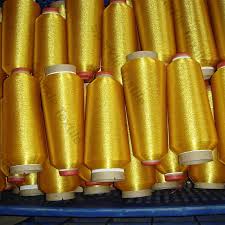
Mettallic Yarn
5605
S47, S51, S52, S54 and many more.
Saudi Arabia, Africa, Bangladesh, Oman, UAE, etc.
We can Costomize as per the customers requirement from Size, Yards , Meters, to Weight also and Private Labeling or White Labeling also Possible with us.





Textiles and Apparel:
- Clothing: Metallic yarn can be woven or knitted into fabrics to create garments with a metallic sheen. This is often used in fashion for special occasions or to add a touch of glamour.
- Accessories: Metallic yarn is popular for creating accessories such as scarves, shawls, and hats, providing a festive or elegant touch.
Home Decor:
- Decorative Fabrics: Metallic yarn can be incorporated into decorative fabrics for items like curtains, tablecloths, and pillow covers to add a touch of luxury.
- Crafts: It’s often used in crafting projects, such as making holiday decorations, ornaments, or embellishing other home decor items.
Embroidery and Needlework:
- Embroidery: Metallic yarn is frequently used in hand and machine embroidery to add a shiny and decorative element to designs.
- Cross-stitch and Needlepoint: Crafters use metallic yarn to accentuate specific areas in cross-stitch or needlepoint projects, creating a sparkling effect.
Yarn Blending:
- Blending with Other Yarns: Metallic yarn can be blended with traditional yarns to create unique textures and effects in knitting or crocheting projects.
Gift Wrapping and Packaging:
- Gift Wrapping: Metallic yarn can be used to tie bows or wrap gifts, adding a festive and eye-catching element.
- Packaging: In the world of product packaging, metallic yarn can be incorporated into labels or tags for a high-end or attention-grabbing look.
Crafting and DIY Projects:
- Art and Mixed Media: Artists and crafters often use metallic yarn in mixed media projects, collages, and other artistic endeavors.
- DIY Projects: From handmade cards to scrapbooking, metallic yarn can be a versatile material for various do-it-yourself projects.
Special Occasion Items:
- Weddings and Events: Metallic yarn is commonly used in creating items for weddings and other special events, such as decorative elements for invitations, favors, and ceremony decor.
Knit Fabrics:
- Sweaters: Metallic yarn is frequently used in the production of knitted sweaters to create a shimmering or metallic effect.
Woven Fabrics:
- Evening Gowns and Dresses: Metallic yarn can be woven into fabrics used for elegant evening gowns and dresses, providing a glamorous and luxurious appearance.
Embroidery:
- Embroidered Fabrics: Metallic yarn is commonly used in embroidery to add metallic threads for decorative patterns on various fabrics, including denim, cotton, or silk.
Lace:
- Lace Fabrics: Metallic yarn is often incorporated into lace fabrics to add a subtle or bold metallic sheen, creating intricate and stylish patterns.
Accessories:
- Scarves and Shawls: Metallic yarn is used in the production of scarves and shawls to create a lightweight and fashionable accessory with a hint of metallic glamour.
Home Textiles:
- Curtains and Drapes: Metallic yarn can be used in the weaving of curtain and drape fabrics, providing a touch of elegance and sophistication.
Upholstery:
- Furniture Upholstery: In some cases, metallic yarn may be incorporated into upholstery fabrics for furniture, adding a decorative element to sofas, chairs, and other furnishings.
Costumes:
- Theatrical Costumes: Metallic yarn is often used in the creation of costumes for theatrical performances, adding a vibrant and eye-catching element under stage lights.
Fashion Accessories:
- Bags and Purses: Metallic yarn can be woven or knitted into fabrics used for bags and purses, creating stylish accessories with a metallic touch.
Footwear:
- Shoes: Metallic yarn is sometimes used in the production of fabrics for shoes, providing a unique and trendy appearance.
- Selection of Base Thread:
- Metallic yarns are made by wrapping a metallic film or foil around a core thread. The first step is to select a suitable base thread. This thread can be made of various materials such as polyester, nylon, or rayon.
- Coating the Base Thread:
- The selected base thread is coated with a thin layer of metallic film or foil. This metallic layer is what gives the yarn its distinctive appearance and properties.
- Metallic Coating Process:
- The metallic coating can be applied using various methods, such as vacuum deposition, sputtering, or laminating. Vacuum deposition involves evaporating the metallic material in a vacuum, allowing it to condense on the base thread. Sputtering involves bombarding a target material with ions, causing it to release metallic particles that adhere to the thread.
- Coloring Process:
- Once the metallic coating is applied, the yarn may undergo a coloring process to achieve the desired color. This can involve dyeing or coating the metallic layer with colored materials. The color selection is often based on customer preferences or specific design requirements.
- Twisting or Plying:
- The metallic-coated base thread may undergo twisting or plying with other threads to create a more stable and durable yarn. This step helps improve the yarn’s strength and overall performance.
- Winding onto Spools or Cones:
- The finished metallic yarn is wound onto spools or cones, making it easier to handle and distribute for further processing or for use in textile manufacturing.
- Quality Control:
- Throughout the manufacturing process, quality control measures are implemented to ensure that the metallic yarn meets specified standards. This may include checking for uniform coating, color consistency, and overall yarn integrity.
- Packaging:
- The final metallic yarn is packaged for shipment or distribution. Packaging methods may vary depending on the specific requirements of the manufacturer or end-user.


